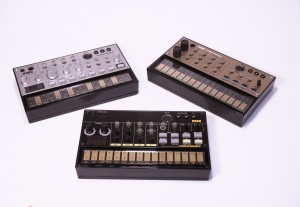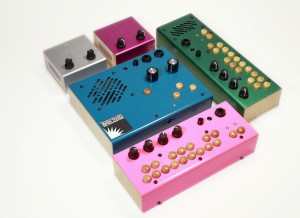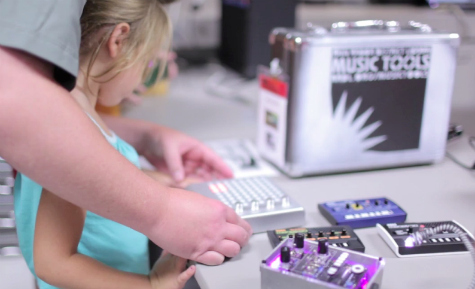A few days ago I found myself wandering around the main branch of the Ann Arbor District Library (AADL). As I’m on the Ann Arbor Ypsilanti Reads 2015 selection committee, I’d been asked to come in and pick up copies of the two books we’d be choisng between, and, as I hadn’t been in the building in a year or so, it took me a while to get my bearings. So I just kind of stumbled around for a few minutes, bouncing between various displays. And, before too long, I found myself staring at a large wall of items that could probably be best described as non-traditional, at least within the context of a public library. Among other things, there were solar chargers, synthesizers, and telescopes, all packed up neatly in black bags, ready to be checked out. Intrigued, I followed up later with that evening with a friend at the library who put me in touch with AADL Deputy Director Eli Neiburger. Following is our discussion.
MARK: I’d been aware, since first moving to Ann Arbor about 20 years ago, that people could check out works of art though the library. I wasn’t aware until just recently, however, that you’d branched out so broadly with regard to non-traditional items. What’s been the impetus behind it?
ELI: First off, thanks for your interest in our Unusual Stuff to Borrow collection… And we love your blog!
As you noted, it all started with the art prints. The AADL has been circulating them since it was the AAPL. And the collection’s been a big success for over 35 years… Then, a few years ago, we started a circulating telescope collection in partnership with the University Lowbrow Astronomers. The demand was huge, so kept adding to it. (We now have 30 telescopes in circulation!) Then, we applied for an IEEE (Electrical Engineer’s association) grant to create a circulating collection of small synthesizers. We didn’t get the grant, but we decided to try it anyway, and established the Music Tools collection. Since then, we’ve added Science Tools, Home Tools, and Outdoor Games. And we just launched Art Tools.
MARK: What is it that’s been pushing you in this direction?
ELI: Beyond the demand we’re seeing for these collections, the strongest impetus comes right from our mission statement, which includes, “We are committed to sustaining the value of public library services for the greater Ann Arbor community through the use of traditional and innovative technologies.”
Public libraries are very good at sharing scarce objects efficiently and equitably. And a lot of commercially-produced materials are no longer very scarce. Things are moving online, and content is becoming less scarce and less valuable. But it’s going to be a long time before you can download a telescope, or a set of lawn checkers! Acquiring some of these truly scarce and unusual objects, and making them available for public usage, sustains the value of the public library, and offers a truly unique service to our cardholders.
MARK: Generally speaking, is this a trend in libraries across the country, or would you say it’s relatively unique to Ann Arbor?
ELI: There are many instances of this kind of collection going back decades, and there are certainly other libraries experimenting, and putting new things on their shelves. There are a bunch of tiny libraries in the rural midwest that have cake pan libraries, and our telescope collection was inspired by a program in New Hampshire. But there are certainly tools in AADL’s collection you won’t find at any other library, like a theremin, or a resonance bowl, or a Sabertooth Cat skull. We’re also following ideas from other libraries; the Chicago Public Library recently launched a circulating robot collection, and we’re testing those same Finch Robots for circulation as well.
 MARK: What’s the process by which you test out new ideas and determine whether or not to move forward with specific items?
MARK: What’s the process by which you test out new ideas and determine whether or not to move forward with specific items?
ELI: Some ideas come from library staff, and some are suggested by the public. Jody Harnish is the production librarian who does most of the development of this collection, and he does the research to see what’s available, what items are well-reviewed, and which are most suitable for shared use and circulation. We look for things that are more expensive than just an impulse buy, that aren’t needed for very long, and that aren’t needed very often. This rules out things like screwdrivers or lawn mowers. Once we’ve identified some potential items, we’ll typically get one or two to test. We’ll first do some test usage among library staff that are interested or experienced with that type of item, and, if the item is working well, and it’s easy to use and support, we’ll do some test checkouts directly to super patrons who have experience in that particular area. And then we’ll ask for feedback about the item, the included accessories, the accompanying documentation, etc. And, if everything looks good, we’ll determine if any further development is needed. (We sometimes have to create more detailed instructions.) Then we’ll get a few more of the item and prepare them for circulation, including cataloging, final packaging, and such… Then it hits the shelf, where it’s ready for use by AADL cardholders!
MARK: Are there additional areas that you’d like to move into in the future?
ELI: We’ve recently added guitar pedals to the Music Tools collection, and those have met with strong demand too, so we’re looking at other things that bands might occasionally need, like a portable PA. We’re also testing thermal imaging cameras now, and we’d like to try GoPro cameras too. There’s a lot of room for the collection to grow and a lot of stuff that people would like to have infrequent, temporary access to.
MARK: What are some of the more interesting requests that you’ve received from the community?
ELI: One of our earliest requests was for a drum carder and a spinning wheel to help turn wool into yarn. We’re working on those! We also recently had a request for the Philips Hue LED bulbs that you can change the color of from an app. We’re taking a look at those too, although that’s more of a try-before-you-buy sort of checkout, which isn’t a major focus of the collection.
 MARK: It’s interesting to think about the role of libraries in a word where so much written work is being delivered in non-traditional formats (i.e. via Kindle). I suspect that this is something that keeps you librarian types up at night…
MARK: It’s interesting to think about the role of libraries in a word where so much written work is being delivered in non-traditional formats (i.e. via Kindle). I suspect that this is something that keeps you librarian types up at night…
ELI: Well, only if you don’t have a vision for libraries beyond the book. This is a golden age of reading and writing. More humans are doing it than ever before. It’s just not all print anymore. But, in the 3,000-year history of libraries, we’ve seen a lot of formats come and go. There’s still very strong demand for print, and the reports of the death of the book have been greatly exaggerated. We’ll have physical media on the shelves for as long as people are coming in to check them out. But diversifying library services to appeal to a broader audience is a win-win for libraries and the communities they serve. There are certainly people who don’t read much print anymore, and it’s their library too.
MARK: Is there any chance we might see things like this expanding throughout Washtenaw County? Might we one day see an instrument wall in the downtown Ypsi library, or telescopes available through interlibrary loan?
ELI: That would be up to the other libraries in the county! These collections are funded through our normal materials budget, and any library could choose to do that. Interlibrary loan isn’t likely as the systems that handle it are built around easily shippable books. I’m not aware of libraries that have these “realia” collections (the library science term for things that aren’t media) that send them out via interlibrary loan, probably because of the logistical challenges.
MARK: Do you foresee a time when 3D printers and the like might be available at the AADL?
ELI: That’s already a big thing in public libraries. The “maker” movement has taken many libraries by storm and they’re buying 3D printers and laser cutters and such. AADL isn’t typically an early adopter on that kind of thing, and here in Ann Arbor there’s already All Hands Active, and the UM 3D Lab which is open to the public, and the membership-driven Maker Works, so there’s already opportunity to try that stuff out. The tech is also still really young and more of a novelty at the moment. Ultimately, I think 3D printing will become a staple at public libraries just the way that 2D printing did, and, while it’s a great service to provide, it was more an iteration than a big transformation of library service. Libraries have been centers of access and creation for centuries, now it’s just moving beyond the written word, as text has become ubiquitous.
MARK: Is there anything else you’d like for people to know about the AADL realia collection?
ELI: Come try it out! Even if you don’t live in the AADL district, you can try the items in the building. And anyone can buy into the AADL and get borrowing privileges for quarterly payments of $37.50… a single checkout of many of these items pays that back right away, without even glancing at our book, DVD, or Blu-ray collections. And we want to hear from our users what they’d like to see on the shelves, especially when it’s an item they know something about!

